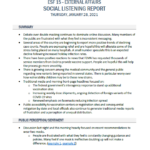
Debate over double masking continues to dominate online discussion. Many members of the public are frustrated with what they feel is inconsistent messaging.
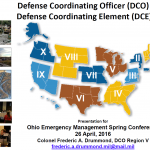
On order and in response to natural/manmade incidents, the Defense Coordinating Officer / Defense Coordinating Element (DCO/DCE) anticipates and conducts Defense Support of Civil Authorities (DSCA) operations coordinating Title 10 forces and resources in support of the Federal Primary Agency (PA) in order to minimize impacts to the American people, infrastructure and environment.
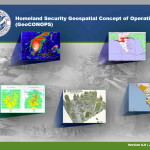
This Homeland Security (HLS) Geospatial Concept of Operations (GeoCONOPS) has been developed as a strategic starting point for understanding how the coordination of Homeland Security and Homeland Defense (HD) geospatial activities can be improved at the federal level. The intended audience for this document is the full geospatial community supporting the missions of the federal government under the National Response Framework (NRF) and Presidential Policy Directive 8 (PPD-8). This includes the stakeholders and actors representing the Emergency Support Functions (ESFs), the Joint Field Offices (JFO), Federal Operations Centers, the disaster preparedness exercise and evaluation community, and those involved in other NRF missions. Individuals representing these groups and activities have been extensively engaged in providing input for this document.

Urban Shield is a continuous, 48-hour Full Scale Multi-Disciplinary Homeland Security/Disaster Preparedness Exercise hosted by the Alameda County Sheriff’s Office, with the support of the Bay Area Urban Area Security Initiative (UASI), and more than 200 local, state, federal, international and private sector partners.
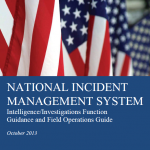
This document includes guidance on how various disciplines can use and integrate the I/I Function while adhering to NIMS concepts and principles. It includes information intended for the NIMS practitioner (including the Incident Commander/Unified Command [IC/UC]) that assists in the placement of the I/I Function within the command structure; provides guidance that may be used while implementing the I/I Function; and has an accompanying Intelligence/ Investigations Function Field Operations Guide (I/I FFOG). While this document provides an example of the I/I Function at the Section level, the IC/UC has the final determination of the scope and placement of the I/I Function within the command structure. The guidance provided in this document is applicable for both domestic incidents that use conventional unclassified information (e.g., open source information, criminal histories, medical records, or educational records) and terrorism incidents where information is often classified and requires the use of national intelligence capabilities.
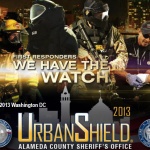
Urban Shield is a continuous, 48-hour Full Scale Multi-Disciplinary Homeland Security/Disaster Preparedness Exercise hosted by the Alameda County Sheriff’s Office, with the support of the Bay Area Urban Area Security Initiative (UASI), and more than 150 local, state, federal, international and private sector partners.
This guide offers recommendations for local outreach campaigns, explains how to effectively develop and disseminate messages in order to help the public better understand their role in reporting suspicious activity, and helps law enforcement agencies and community partners to understand, navigate, and use the many resources available to help build and sustain local efforts. New technologies, resources, and innovative practices highlighted within this document can be used to improve the education, communication, and trust amongst communities and law enforcement agencies who serve them. With the proper tools and knowledge, individuals and entire communities will help law enforcement agencies identify, investigate, and prevent crime and terrorism.
The Homeland Security Geospatial Concept of Operations (GeoCONOPS) provides an understanding of the current landscape for the coordination of disaster response geospatial activities at the Federal level. The document serves the geospatial communities that support emergency management activities of the Federal government under Presidential Policy Directive 8 (PPD-8). This includes individual Emergency Support Functions (ESFs), the Joint Field Offices, FEMA Regional Coordination Centers (RRCC), and the National Response Coordination Center (NRCC). Stakeholders and actors representing the federal geospatial community have been extensively engaged in providing input for the development of the GeoCONOPS document. The GeoCONOPS serves as a guide to the Federal departments and agencies providing geospatial support under the Stafford Act which defines the programs and processes by which the Federal Government provides disaster and emergency assistance to state and local governments, tribal nations, eligible private nonprofit organizations, and individuals affected by a declared major disaster or emergency.
DHS National Protection and Programs Directorate Protective Security Advisors and Special Event Domestic Incident Tracker Overview presented at the FEMA National Preparedness Symposium on August 8, 2012.
On Monday, May 16, 2011, thousands of players across the United States received notification of a simulated catastrophic earthquake in the New Madrid Seismic Zone (NMSZ), officially kicking off the National Level Exercise 2011 (NLE 11) functional exercise. From May 16–19, 2011, Federal, state, regional, local, international, nongovernmental, and private sector partners participated in the exercise, the capstone event of a White House-directed, congressionally mandated cycle of planning and preparedness events. Notably, exercise activities were carefully balanced with ongoing efforts to respond to and recover from real-world flooding and tornado-related disasters in the Southern and Central United States. Although some partners, including the four states in FEMA Region IV (Alabama, Kentucky, Mississippi, and Tennessee), had to reduce their participation in NLE 11 due to these events, their actions, requests, and decisions were simulated to allow for robust and realistic exercise play. Simultaneously conducting NLE 11 and managing real-world disasters resulted in a realistic “worst-case scenario.” Consequently, players were able to test the Nation’s ability to respond to several devastating events, strengthening the country’s preparedness through their efforts.
The Federal Emergency Management Agency’s (FEMA) Individual and Community Preparedness Division partnered with the International Association of Chiefs of Police (IACP) on a project to research and develop a strategy to improve the public’s awareness and reporting of suspicious activity. In early 2010, IACP conducted research of contemporary and historical practices intended to improve the public’s reporting of suspicious activity. The literature review showed that little research existed on the motivations and barriers that affect whether or not individuals report information to law enforcement. To close this gap in data, IACP developed a three phase primary research strategy. This report provides an overview of key research findings and provides insights and recommendations that support national and local campaigns.
Rather than combating natural disasters or a nuclear detonation in a major U.S. city, this year’s National Level Exercise will focus on cyber threats to critical infrastructure and the “real world” implications for government and law enforcement of large-scale cyber attacks. National Level Exercise 2012 (NLE 2012) is scheduled to take place in June and will involve emergency response personnel from at least thirteen states, four countries, nearly every major governmental department as well as a number of private companies, non-governmental organizations, institutions of higher education and local fusion centers. The exercise will span four FEMA regions and will include scenarios affecting the National Capital Region.
National Level Exercise (NLE) 2012 Overview for Northeast Disaster Recovery Information X-Change (NEDRIX) from March 14, 2012.
This document is intended to provide private sector stakeholders with an overview of NLE 2012, to include a discussion of the exercise timeline, a snapshot of the exercise scenario, and a review of the various potential exercise participation opportunities.
A contract solicitation posted to the Federal Business Opportunities website between February 10 – 24, 2012 concerning the construction of a temporary camp anywhere in the continental United States (CONUS) within 72 hours in a disaster-impacted area or “any other situation where FEMA or an agency working through FEMA needs a RSC” to host up to 2,000 responders and emergency staff as well as displaced citizens.
Version 3.0 Federal Interagency Geospatial Concept of Operations (GeoCONOPS) final draft from June 2011.
FOUO FEMA National Level Exercise 2011 Overview Presentation from January 12, 2011.
Focus: Domestic, non-terrorism; Major Earthquake (specific focus on a catastrophic earthquake in the New Madrid Seismic Zone (NMSZ)) the exercise concept was created in 2006 as a follow-on task to the Federal Emergency Manage Agency (FEMA) NMSZ Catastrophic Planning Initiative. NLE 11 will be a Functional Exercise (FE) that will last approximately four days with a specific focus on the first 72 hours. This exercise is designed to provide FEMA with a crucible to test Administrator Fugate’s mission for the Federal government to make decisions and take action within the first 72 hours of a major disaster that will have positive effect on life saving and life sustaining activities.
In the event of a catastrophic incident or threat to the National Capital Region (NCR), the significant federal presence would both necessitate and complicate a robust response. In order to facilitate the coordination that would be required for the integration of federal, state, and local response efforts, the Office of Personnel Management (OPM) and the FEMA Office of National Capital Region Coordination (NCRC) have compiled this draft NCR Federal Concept Plan (CONPLAN) of Catastrophic Planning Assumptions. For planning purposes, a catastrophic incident is defined in the National Response Framework as any natural or manmade incident, including terrorism, which results in an extraordinary level of mass casualties, damage, or disruption severely affecting the population, infrastructure, environment, economy, national morale, and/or government functions.
The purpose of this ―battle book is to provide the FEMA Director with background information and recommended checklist actions on scenarios that may require a significant response operation under the National Response Plan. This document is intended to serve as a ―one stop reference that includes information on the agency’s emergency teams and resources.
The United States (U.S.) Government, along with other nations, international organizations, and nongovernmental organizations, rushed to provide critical life-saving and other assistance to Haiti. President Barack Obama directed the U.S. Agency for International Development (USAID) to lead the coordination of the U.S. Government assistance to Haiti. USAID worked with other Federal agencies to organize and deliver assistance to the victims of the earthquake. The Department of Homeland Security (DHS) deployed over 1,000 personnel from various components to support U.S. assistance in Haiti. As of April 2, 2010, the U.S. Government had provided over $1 billion in assistance to Haiti.
In accordance with Title IV of Public Law (PL) 110-53, “Implementing Recommendations of the 9/11 Commission Act of 2007,” the Administrator of the Federal Emergency Management Agency (FEMA) defined Federal and Mutual Aid Emergency Response Officials (F/EROs) as personnel with responsibilities under the National Response Framework (NRF), National Infrastructure Protection Plan (NIPP), the National Continuity Policy Implementation Plan (NCPIP), and / or the National Incident Management System (NIMS). Additionally, Title IV requires the establishment of an inventory or database system of F/EROs.
In a rather bizaare turn of events, representatives of FEMA have again contacted us requesting the removal of a document from out site. Previously, we were contacted by FEMA regarding the “National Level Exercise 2010 (NLE 10) Exercise Overview” which we had posted more than seven months prior. This time they are requesting that we remove one of the first documents that we ever posted in May 2009. The document is a brief presentation discussing Electronic Designation and Validation of Federal/Emergency Response Officials (F/EROs) in support of National Preparedness in the National Capital Region. In fact, it has only 25 slides in its entirety.